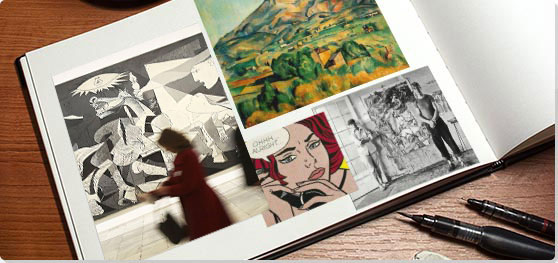Summary of Modern Art
Modern art represents an evolving set of ideas among a number of painters, sculptors, photographers, performers, and writers who - both individually and collectively - sought new approaches to art making. Although modern art began, in retrospect, around 1850 with the arrival of Realism, approaches and styles of art were defined and redefined throughout the 20th century. Practitioners of each new style were determined to develop a visual language that was both original and representative of the times.
Overview of Modern Art
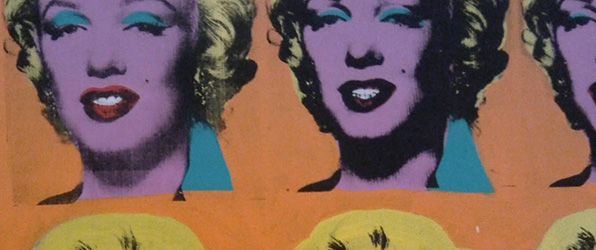
The rapid growth of industry and the progress of technology propelled artists to represent the world in new and innovative ways. The result was an art that took on new colors, alternative forms, emotional expressions, and experiments in abstraction.
The Important Artists and Works of Modern Art
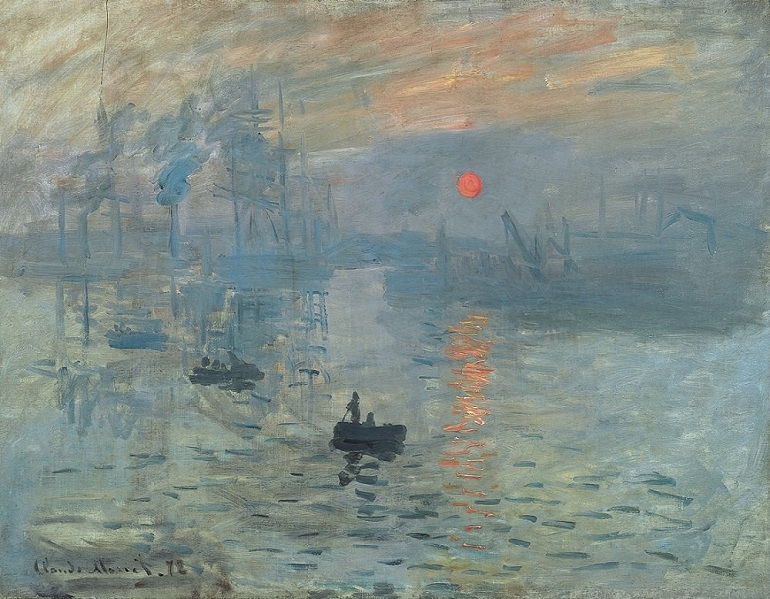
Impression, Sunrise
In this seminal work of modern art, Monet's loose handling of paint and his focus on light and atmosphere within the landscape scene are all key characteristics of Impressionism, which is widely considered the first fully modern movement. Monet's use of abstraction evokes what the artist sensed or experienced while painting the scene, which was a highly unusual approach for a painter to adopt at the time. The title of the work, Impression, Sunrise not only provided critics with the name that the movement would later receive, but also conveys the transitory, fleeting and subjective nature of the painting. It is Monet's visual impression of what he observed during that sunrise.
Oil on canvas - Musée Marmottan Monet
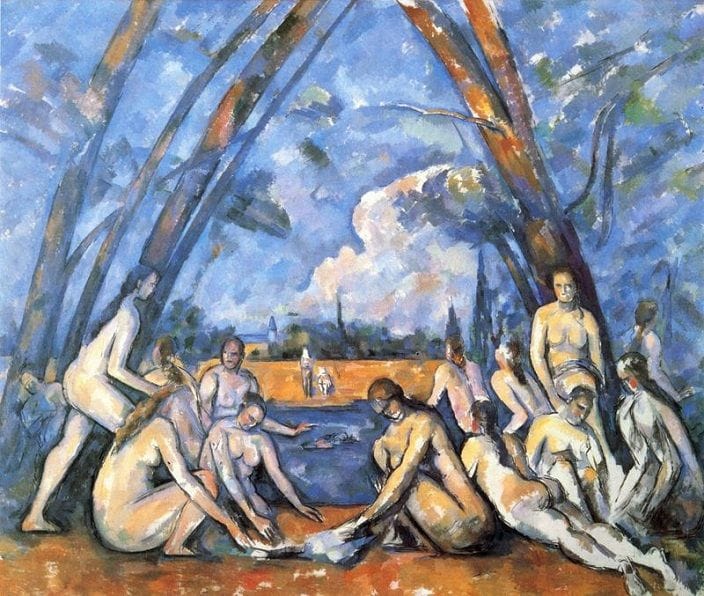
The Large Bathers
The Large Bathers is one of the finest examples of Cézanne's exploration of the theme of the modern, heroic nude within a natural setting. The series of nudes are arranged into a variety of positions, like objects in a still life, under the pointed arch formed by the intersection of trees and the sky. Cézanne was attempting a departure from the Impressionist motifs of light and natural effect and instead composed this scene as a series of carefully constructed figures, as if creating sculpture with his paintbrush. He was more concerned with the way the forms occupied space than with recording his visual observations. This destruction of regular illusionism and the radical foray into increased abstraction is considered an important precursor to Cubism.
Oil on canvas - The Philadelphia Museum of Art

Les Demoiselles d'Avignon
For Les Demoiselles d'Avignon, Picasso gathered inspiration from a variety of sources, including African tribal art, Expressionism, and the Post-Impressionist paintings of Paul Cézanne. Assimilating these seemingly disparate sources in one piece was a new approach to art making and conveys just how much artists' perspectives expanded with the rise of modernism. The painting originally raised significant controversy for its depiction of a brothel scene and for the jagged, protruding, and abstract forms used to depict the women. It is also widely considered the artwork that launched the Cubism movement. The multiplicity of styles incorporated within this work - from Iberian sculpture referenced in the women's' bodies to the sculptural deconstruction of space derived from Cézanne - not only represent a clear turning point in Picasso's career, but make the painting an incredibly distinct achievement of the modern era.
Oil on canvas - The Museum of Modern Art, New York City
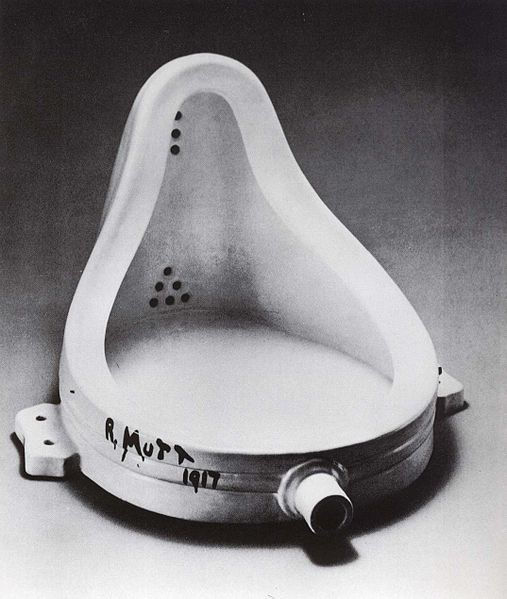
Fountain
Duchamp's invention of the readymade - a manufactured, found object divorced from its utilitarian purpose and presented in a new way as art - helped redefine what constituted a work of art within the modern era. Henceforth, a unique work of art no longer required the act of creation by the artist or visual evidence of the artist's hand in its production, the artist merely needed to designate the work as art for it to be considered as such. Duchamp's Fountain is a mass-produced porcelain urinal, turned on its back and inscribed with the name R. Mutt, a combination of a plumbing company name and a comic. By using an everyday, prefabricated object Duchamp forced the viewer to reconsider the definition of art and who makes that definition. This work in particular, and other readymades, were major influences on the later movements of Pop art, which focused on combining low and high art, and Conceptualism, wherein the idea behind the artwork is as important as the final object.
Porcelain - The Philadelphia Museum of Art
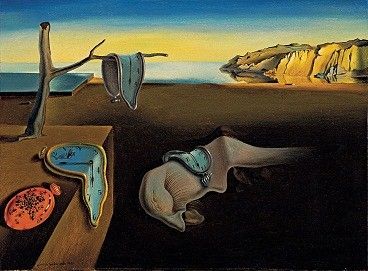
The Persistence of Memory
This iconic Surrealist painting naturalistically depicts an otherworldly landscape where time is a series of melting watches surrounded by swarming ants that hint at decay, an organic process which held great fascination for Dalí. He sought to portray "images of concrete irrationality," bringing haunting dreamscapes, like this allegorically empty space where time has no power, out of the subconscious mind and onto the canvas. Dalí's celebrated and vivid imagination, his fascination with dream imagery and metaphor, and his exploration into the human subconscious all follow the key characteristics of the Surrealism movement in the early-20th century.
Oil on canvas - The Museum of Modern Art, New York City
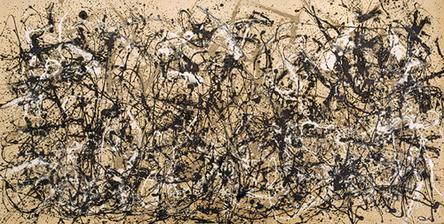
Autumn Rhythm (Number 30)
Through the development of his "drip" style of painting, and thedelicate dance executed in the process of creating the work, Jackson Pollock helped define the idea of Action Painting. With these paintings, Pollock - one of the most famous Abstract Expressionists - discovered a new abstract, visual language for his unconscious that moved beyond the Freudian symbolism of the Surrealists. He broke up the rigid, shallow space of Cubist pictures, replacing it with a dense web of lines and forms, like an unfathomable galaxy of stars. In some respects this work evokes both Impressionism and Surrealism, in the loose, gestural application of the paint and the unconscious nature of the expression laid down on the canvas.
Enamel on canvas - The Metropolitan Museum of Art, New York City
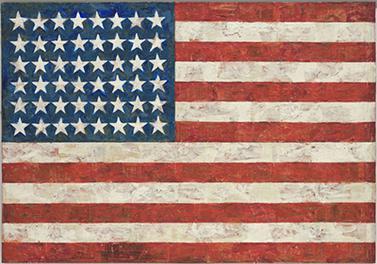
Flag
Flag, Johns' first major work, broke away from the emotionally driven style of the Abstract Expressionists by portraying a recognizable, everyday object, which according to Johns is "seen but not looked at." Although the work is representational, the painting is also abstract in its many textures, layers, and materials, including strips of newspaper painted over with encaustic, and the tactile brush strokes that create a painterly, expressive surface. Johns turns a flag, a three-dimensional object, into a two-dimensional painting. This practice of appropriating familiar objects recalled the practices of the earlier Dadaists, particularly Marcel Duchamp, who revolutionized modern art with the readymade. Johns' approach with his Flag paintings renewed interest in Dada and was as an important precursor to Pop art particularly through his use of everyday, mass-produced objects.
Encaustic, oil, and collage on fabric mounted on plywood, three panels - The Museum of Modern Art, New York City
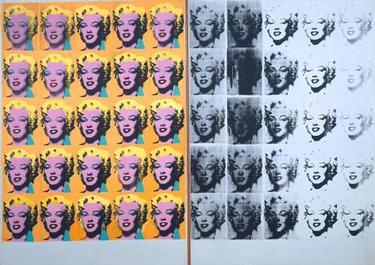
Marilyn Diptych
Andy Warhol completed this work (the first of many devoted to Marilyn Monroe) shortly after the actress's untimely death in August 1962. The image of Monroe, which Warhol recycled and used for all his Marilyn silkscreen paintings, was taken from a publicity shot originally used for the film Niagara. Not dissimilar from Warhol's motifs of Campbell's soup cans or Brillo boxes, the artist stacks and repeats the same image of Monroe here as if she were a consumer product in a grocery store. By juxtaposing the bright colors with monochrome in the diptych, Warhol alludes to her mortality. Though Warhol was a great admirer of the actress, he acknowledged in this and similar works that celebrity was itself a consumer product. Marilyn Diptych is designed as both a tribute to the late icon and a harsh commentary on how we had come to treat these pop cultural icons in the modern era.
Silkscreen ink on synthetic polymer paint on canvas - The Museum of Modern Art, New York City
One Ton Prop (House of Cards)
One Ton Prop presages Serra's mature works, where gravity, weight, counterforce, sinuous movement, and other physical and visual properties are embodied by steel. This sculpture, consisting of four rolled sheets of lead propped on each other, is less a visual exercise for the viewer and more of an intellectual one, obliging one to contemplate the physical properties that allow the piece to remain upright rather than collapse. The unprecedented complexity of such a work is fairly typical of post-minimal sculpture, which relied upon a variety of visual sources and theories for inspiration. While One Ton Prop embodies certain principles of Minimalism, Conceptualism, and even Dada, it is generally referred to as Process art because the process of its construction is inherent and apparent in the final work. The multiplicity of sources and possible styles is typical of the pluralist contemporary world, and the contemporary art that goes with it.
Lead antimony, four plates - The Museum of Modern Art, New York City
Definition of Modern Art
Modern art is the creative world's response to the rationalist practices and perspectives of the new lives and ideas provided by the technological advances of the industrial age that caused contemporary society to manifest itself in new ways compared to the past. Artists worked to represent their experience of the newness of modern life in appropriately innovative ways. Although modern art as a term applies to a vast number of artistic genres spanning more than a century, aesthetically speaking, modern art is characterized by the artist's intent to portray a subject as it exists in the world, according to his or her unique perspective and is typified by a rejection of accepted or traditional styles and values.
The Beginnings of Modern Art
Classical and Early Modern Art

The centuries that preceded the modern era witnessed numerous advancements in the visual arts, from the humanist inquiries of the Renaissance and Baroque periods to the elaborate fantasies of the Rococo style and the ideal physical beauty of 18th-century European Neoclassicism. However, one prevalent characteristic throughout these early modern eras was an idealization of subject matter, whether human, natural, or situational. Artists typically painted not what they perceived with subjective eyes but rather what they envisioned as the epitome of their subject.
Age of Modernism and Art
The modern era arrived with the dawn of the industrial revolution in Western Europe in the mid-19th century, one of the most crucial turning points in world history. With the invention and wide availability of such technologies as the internal combustion engine, large machine-powered factories, and electrical power generation in urban areas, the pace and quality of everyday life changed drastically. Many people migrated from the rural farms to the city centers to find work, shifting the center of life from the family and village in the country to the expanding urban metropolises. With these developments, painters were drawn to these new visual landscapes, now bustling with all variety of modern spectacles and fashions.
A major technological development closely-related to the visual arts was photography. Photographic technology rapidly advanced, and within a few decades a photograph could reproduce any scene with perfect accuracy. As the technology developed, photography became increasingly accessible to the general public. The photograph conceptually posed a serious threat to classical artistic modes of representing a subject, as neither sculpture nor painting could capture the same degree of detail as photography. As a result of photography's precision, artists were obliged to find new modes of expression, which led to new paradigms in art.
The Artist's Perspective and Modern Art
In the early decades of the 19th century, a number of European painters began to experiment with the simple act of observation. Artists from across the continent, including portraitists and genre painters such as Gustave Courbet and Henri Fantin-Latour, created works that aimed to portray people and situations objectively, imperfections and all, rather than creating an idealized rendition of the subject. This radical approach to art would come to comprise the broad school of art known as Realism.
Also early in the 19th century, the Romantics began to present the landscape not necessarily as it objectively existed, but rather as they saw and felt it. The landscapes painted by Caspar David Friedrich and J.M.W. Turner are dramatic representations that capture the feeling of the sublime that struck the artist upon viewing that particular scene in nature. This representation of a feeling in conjunction with a place was a crucial step for creating the modern artist's innovative and unique perspective.
Early Abstraction and Modern Art

Similarly, while some artists focused on objective representation, others shifted their artistic focus to emphasize the visual sensation of their observed subjects rather than an accurate and naturalistic depiction of them. This practice represents the beginnings of abstraction in the visual arts. Two key examples of this are James McNeill Whistler's Nocturne in Black and Gold: The Falling Rocket (1874) and Claude Monet's Boulevard des Capucines (1873). In the former, the artist couples large splatters and small flecks of paint to create a portrait of a night sky illuminated by fireworks that was more atmospheric than representational. In the latter, Monet provides an aerial view of bustling modern Parisian life. In portraying this scene, Monet rendered the pedestrians and cityscape as an "impression," or in other words, a visual representation of a fleeting, subjective, and slightly abstracted, perspective.
Modern Art Themes and Concepts
Modern Artists

The history of modern art is the history of the top artists and their achievements. Modern artists have strived to express their views of the world around them using visual mediums. While some have connected their work to preceding movements or ideas, the general goal of each artist in the modern era was to advance their practice to a position of pure originality. Certain artists established themselves as independent thinkers, venturing beyond what constituted acceptable forms of "high art" at the time which were endorsed by traditional state-run academies and the upper-class patrons of the visual arts. These innovators depicted subject matter that many considered lewd, controversial, or even downright ugly.
The first modern artist to essentially stand on his own in this regard was Gustave Courbet, who in the mid-19th century sought to develop his own distinct style. This was achieved in large part with his painting from 1849-1850, Burial at Ornans, which scandalized the French art world by portraying the funeral of a common man from a peasant village. The Academy bristled at the depiction of dirty farm workers around an open grave, as only classical myths or historical scenes were fitting subject matter for such a large painting. Initially, Courbet was ostracized for his work, but he eventually proved to be highly influential to subsequent generations of modern artists. This general pattern of rejection and later influence has been repeated by hundreds of artists in the modern era.
Modern Art Movements

The discipline of art history tends to classify individuals into units of like-minded and historically connected artists designated as the different movements and "schools." This simple approach of establishing categories is particularly apt as it applies to centralized movements with a singular objective, such as Impressionism, Futurism, and Surrealism. For example, when Claude Monet exhibited his painting Impression, Sunrise (1872) as part of a group exhibition in 1874, the painting and the exhibition as a whole were poorly received. However, Monet and his fellow artists were ultimately motivated and united by the criticism. The Impressionists thus set a precedent for future independently minded artists who sought to group together based on a singular objective and aesthetic approach.
This practice of grouping artists into movements is not always completely accurate or appropriate, as many movements or schools consist of widely diverse artists and modes of artistic representation. For example, Vincent van Gogh, Paul Gauguin, Georges Seurat and Paul Cézanne are considered the principal artists of Post-Impressionism, a movement named so because of the artists' deviations from Impressionist motifs as well as their chronological place in history. Unlike their predecessors, however, the Post-Impressionists did not represent a cohesive movement of artists who united under a single ideological banner. Furthermore, the case can be made that some artists do not fit into any particular movement or category. Key examples include the likes of Auguste Rodin, Amadeo Modigliani, and Marc Chagall. Despite these complications, the imperfect designation of movements allows the vast history of modern art to be broken down into smaller segments separated by contextual factors that aid in examining the individual artists and works.
The Avant-Garde and The Progression of Modern Art
The avant-garde is a term that derives from the French "vanguard," the lead division going into battle, literally advance guard, and its designation within modern art is very much like its military namesake. Generally speaking, most of the successful and creative modern artists were avante-gardes. Their objective in the modern era was to advance the practices and ideas of art, and to continually challenge what constituted acceptable artistic form in order to most accurately convey the artist's experience of modern life. Modern artists continually examined the past and revalued it in relation to the modern.
Modern, Contemporary, and Postmodern Art
Generally speaking, contemporary art is defined as any form of art in any medium that is produced in the present day. However, within the art world the term designates art that was made during and after the post-Pop art era of the 1960s. The dawn of Conceptualism in the late 1960s marks the turning point when modern art gave way to contemporary art. Contemporary art is a broad chronological delineation that encompasses a vast array of movements like Earth art, Performance art, Neo-Expressionism, and Digital art. It is not a clearly designated period or style, but instead marks the end of the periodization of modernism.

Postmodernism is the reaction to or a resistance against the projects of modernism, and began with the rupture in representation that occurred during the late 1960s. Modernism became the new tradition found in all the institutions against which it initially rebelled. Postmodern artists sought to exceed the limits set by modernism, deconstructing modernism's grand narrative in order to explore cultural codes, politics, and social ideology within their immediate context. It is this theoretical engagement with the ideologies of the surrounding world that differentiates postmodern art from modern art, as well as designates it as a unique facet within contemporary art. Features often associated with postmodern art are the use of new media and technology, like video, as well as the technique of bricolage and collage, the collision of art and kitsch, and the appropriation of earlier styles within a new context. Some movements commonly cited as Postmodern are: Conceptual art, Feminist art, Installation art and Performance art.
Useful Resources on Modern Art
-
![Shock of the New (1980)]() 242k viewsShock of the New (1980)Our Pick8 episodes series by legendary critic Robert Hughes
242k viewsShock of the New (1980)Our Pick8 episodes series by legendary critic Robert Hughes -
![This Is Modern Art (1999)]() 393k viewsThis Is Modern Art (1999)Our Pick6 part TV series by English art critic Matthew Collings. Compares Modern art of the past and connecting to contemporary art practices
393k viewsThis Is Modern Art (1999)Our Pick6 part TV series by English art critic Matthew Collings. Compares Modern art of the past and connecting to contemporary art practices -
![The Power of Art (2006)]() 54k viewsThe Power of Art (2006)Our PickEpisodes on Van Gogh, Picasso, and Rothko by art historian Simon Schama
54k viewsThe Power of Art (2006)Our PickEpisodes on Van Gogh, Picasso, and Rothko by art historian Simon Schama -
![Leo Castelli: The First Global Gallerist]() 1k viewsLeo Castelli: The First Global GalleristProfessor and historian Annie Cohen-Solal overviews the life and brilliance of Leo Castelli, the gallerist that brought many Pop artists to fame from Rauschenberg to Rosenquist
1k viewsLeo Castelli: The First Global GalleristProfessor and historian Annie Cohen-Solal overviews the life and brilliance of Leo Castelli, the gallerist that brought many Pop artists to fame from Rauschenberg to Rosenquist -
![The Museum of Modern Art - New York]() 638k viewsThe Museum of Modern Art - New YorkLook inside the history and highlights of the best biggest collection of modern art
638k viewsThe Museum of Modern Art - New YorkLook inside the history and highlights of the best biggest collection of modern art
 Ask The Art Story AI
Ask The Art Story AI